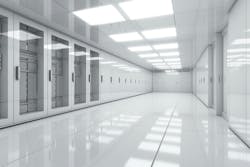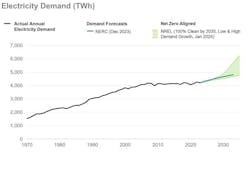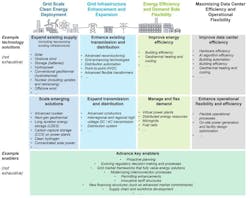DOE Catalogs Clean Energy Resources, Tools to Help U.S. Data Centers Meet Rising Electricity Demand
Stacked with informative tables and links, a new official blog from the U.S. Dept. of Energy's Office of Policy outlines DOE resources presently available "to help data center developers meet electricity demands with clean energy solutions that can improve flexibility and modernize the grid while maintaining reliability and affordability."
Per the DOE's assessment, in response to concurrent transformations in technologies such as artificial intelligence (AI), data center expansion, new domestic manufacturing, and electrification in different sectors, the United States is returning to a period of sharply rising electricity demand, with total energy demand potentially growing ~15-20% in the next decade.
The agency notes that "the last time the United States experienced rising electricity demand was before the early 2000s due to a growing economy, a growing population, and a corresponding change in consumer adoption of electric products such as air conditioners, computers, and incandescent lighting."
Significantly, the blog details numerous DOE resources available to support data center electricity needs (PDF) to address electricity demand, with guidance on topics including:
- Grid Scale Clean Energy Deployment
- Grid Infrastructure Enhancement and Expansion
- Maximizing Energy Efficiency of Data Centers
- Demand Side Flexibility
- Technical Assistance Programs for State and Local Officials, Energy Professionals, Communities, and Large Energy Users
Data Center Demand Growing Rapidly and Varies Regionally
A report set for release at the end of 2024 by DOE’s Lawrence Berkeley National Laboratory (LBNL) is assessing current and near-future data center energy consumption and water use, building its data on a series of congressionally mandated reports on data center energy use and efficiencies.
As further noted by the DOE:
"Data center electricity demand has specific characteristics. It is growing rapidly and varies regionally. Data centers can impact regional grids given the steep increases in load size, may be geographically constrained due to latency requirements, and often require firm power sources to operate continuously. Projections of data center electricity demand growth continue to evolve due to developing use cases and demand for AI and the speed of improvements in energy efficiency."
The blog piece is evidence of how DOE has been anticipating and planning for rising electricity demand underscored by the agency's nationwide goal "to reach net-zero emissions economy-wide" by 2050. On the way to reaching this goal, the agency expects at least a doubling in current electricity demand, including transmission losses and direct use.
(The "double demand" electricity forecast cites data from: last year's North American Electric Reliability Corporation (NERC), Electricity Supply and Demand Data report; the Energy Information Administration (EIA) Monthly Energy Review; and the National Renewable Energy Laboratory (NREL) Pathways to 100% Clean Electricity report of 2022.)
Where A.I. Meets Clean Energy
Meanwhile, citing recent research from Electric Power Research Institute (EPRI) estimating that data centers could grow to consume up to 9% of U.S. electricity generation annually by 2030 (up from 4% of total load in 2023), DOE acknowledges that "at a national level, data centers are critical to supporting America’s economic growth by powering businesses and enabling continued leadership in innovation, including for AI applications."
At the same time, the DOE believes that "near-term data center driven electricity demand growth is an opportunity to accelerate the build-out of clean energy solutions, improve demand flexibility, and modernize the grid while maintaining affordability."
The agency cites solar energy, land-based wind energy, battery storage, and energy efficiency as "some of the most rapidly scalable and cost competitive ways to meet increased electricity demand from data centers."
Significantly, the blog adds:
"Given data centers’ need for clean firm power, scaling other energy technologies, such as next-generation geothermal and nuclear, will also be critically important to meet data center electricity demand. With greater investment today, these energy solutions, which are covered by DOE’s Pathways to Commercial Liftoff reports, could enable hundreds of gigawatts of capacity on the grid by the mid-2030s and through 2050 to help meet the energy and power needs of data centers and increase the reliability and affordability of the power system."
Examples of Tools to Address Growing Electricity Demand from Data Centers
Also in the blog, the DOE emphasizes how an energy efficiency ethos is a key tool in reducing energy consumption from data center facilities.
The blog notes how the agency's long-standing commitment to developing improved cooling technologies, including for data centers, is embodied by the ongoing COOLERCHIPS program from ARPA-E, focused on commercializing innovative cooling technologies for data centers.
As one proof point of the government's adeptness in state-of-the-art techniques for data center efficiency, the agency points out that DOE national labs have built exascale computing facilities with a Power Usage Efficiency (PUE) of 1.03.
Read the full blog at Energy.gov: "Clean Energy Resources to Meet Data Center Electricity Demand."
About the Author
Matt Vincent
A B2B technology journalist and editor with more than two decades of experience, Matt Vincent is Editor in Chief of Data Center Frontier.





